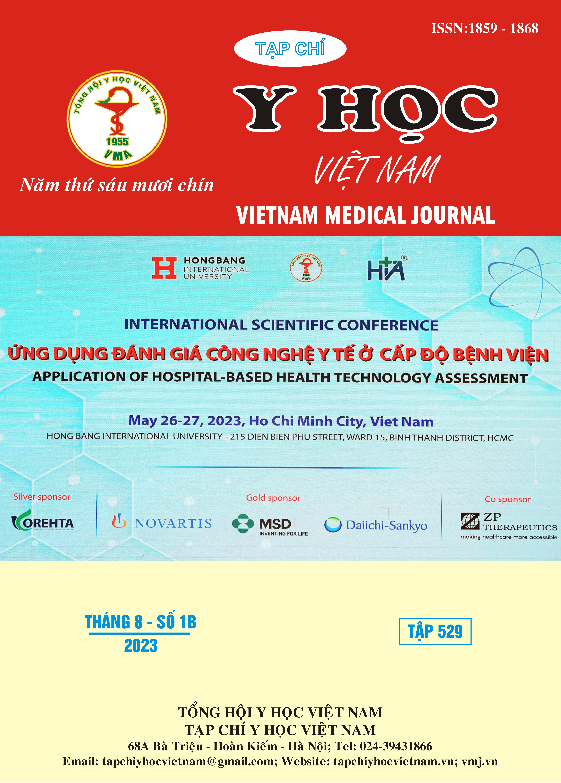ĐẶC ĐIỂM LÂM SÀNG VÀ MỘT SỐ YẾU TỐ LIÊN QUAN Ở BỆNH NHÂN RÁM MÁ TẠI BỆNH VIỆN TRƯỜNG ĐẠI HỌC Y DƯỢC CẦN THƠ VÀ VIỆN NGHIÊN CỨU DA THẨM MỸ QUỐC TẾ FOB NĂM 2022-2023
Nội dung chính của bài viết
Tóm tắt
Đặt vấn đề: Rám má là một bệnh lý da phổ biến, có thể gây ảnh hưởng đến thẩm mỹ, chất lượng cuộc sống của bệnh nhân. Mục tiêu: Mô tả đặc điểm lâm sàng và một số yếu tố liên quan của bệnh rám má tại Bệnh viện Trường Đại học Y Dược Cần Thơ và Viện nghiên cứu da thẩm mỹ quốc tế FOB năm 2022-2023. Đối tượng và phương pháp nghiên cứu: Nghiên cứu mô tả cắt ngang trên 97 bệnh nhân đến khám và được chẩn đoán bệnh rám má tại Bệnh viện Trường Đại học Y dược Cần Thơ và Viện nghiên cứu da thẩm mỹ quốc tế FOB từ 08/2022 tới 08/2023. Kết quả: Đặc điểm lâm sàng của bệnh rám má: đa số (81,5%) đối tượng rám má trên 3 năm và 18,5% dưới 3 năm; 4 thể lâm sàng như trung tâm mặt (50,5%), dạng hỗn hợp (22,7%), cánh bướm (21,6%), hàm dưới (5,2%); Phân loại rám má bằng đèn Wood’s cho thấy thượng bì 56,7%, hỗn hợp 32%, trung bì 11,3%; Mức độ rám má dựa trên sắc tố và diện tích tổn thương thấy được trung bình (nâu) 46,4%, nặng (nâu tối) 33%, nhẹ (nâu sáng) 16,5%, rất nặng (đen) 4,1%; Mức độ rám má dựa trên chỉ số MASI kết quả cho thấy nặng 37,1%, trung bình 27,8%, rất nặng 19,6%, nhẹ 15,5%. Phân bố mức độ rám má dựa trên chỉ số MASI được ghi nhận liên quan mang ý nghĩa thống kê với các đặc điểm: tuổi; BMI; thời gian tiếp xúc ánh sáng mặt trời; đeo khẩu trang; bôi kem chống nắng; kinh nguyệt và số lần sinh con với p<0,05. Kết luận: Tất cả đối tượng rám má trong nghiên cứu đều là nữ với thể trung tâm mặt nhiều nhất 50,5%, phân loại rám má bằng đèn Wood’s thượng bì chiếm đa số 56,7%; mức độ rám má dựa trên sắc tố và diện tích tổn thương trung bình (nâu) nhiều nhất 46,4%, dựa trên chỉ số MASI kết quả cao nhất nặng 37,1%.
Chi tiết bài viết
Từ khóa
rám má, đặc điểm lâm sàng, đèn Wood’s, MASI.
Tài liệu tham khảo
2. Benchikhi H, Atide N, Jroundi I, Humbert P, Lakhdar H. Risk factors in facial hyperpigmentation in Maghrebian population - a case-control study. Int J Cosmet Sci. 2012 Oct;34(5):477-80. PubMed PMID: 22784199. eng.
3. Guinot C, Cheffai S, Latreille J, Dhaoui MA, Youssef S, Jaber K, et al. Aggravating factors for melasma: a prospective study in 197 Tunisian patients. J Eur Acad Dermatol Venereol. 2010 Sep;24(9):1060-9. PubMed PMID: 20202051. eng.
4. Guo X., Cai X., Jin Y., et al., (2019), Q-PTP is an optimized technology of 1064-nm Q-switched neodymium-doped yttrium aluminum garnet laser in the laser therapy of melasma: A prospective split-face study, Oncology Letters. 18, pp. 4136-4143.
5. Hexsel D, Rodrigues TC, Dal'Forno T, Zechmeister-Prado D, Lima MM. Melasma and pregnancy in southern Brazil. J Eur Acad Dermatol Venereol. 2009 Mar;23(3):367-8. PubMed PMID: 18631207. Epub 2008/07/18. eng.
6. Ingber A. Obstetric Dermatology, Springer-Verlag Berlin Heidelberg 2009.
7. Kligman AM, Fulton JE, Plewig G. (2003), Topical vitamin A acid in acne vulgaris, Arch Dermatol, pp. p 40-48.
8. Moin A, Jabery Z, Fallah N. Prevalence and awareness of melasma during pregnancy. Int J Dermatol. 2006 Mar;45(3):285-8. PubMed PMID: 16533230. Epub 2006/03/15. Eng.
9. Tamega AdA, Miot LDB, Bonfietti C, Gige TC, Marques MEA, Miot HA. Clinical patterns and epidemiological characteristics of facial melasma in Brazilian women. Journal of the European Academy of Dermatology and Venereology. 2012:no-no. eng.
10. Wong RC, Ellis CN. Physiologic skin changes in pregnancy. J Am Acad Dermatol. 1984 Jun;10(6):929-40. PubMed PMID: 6376552. Eng.


